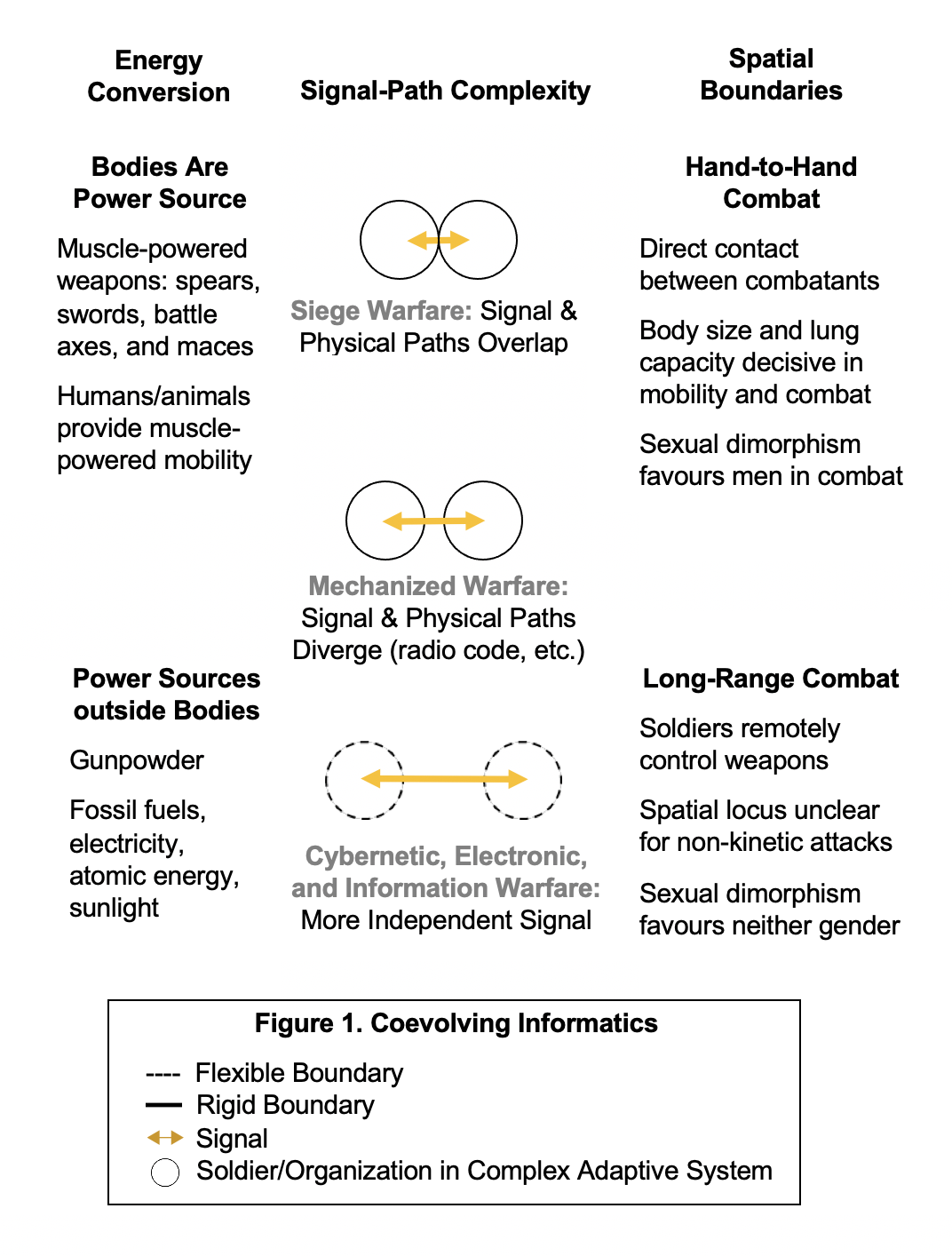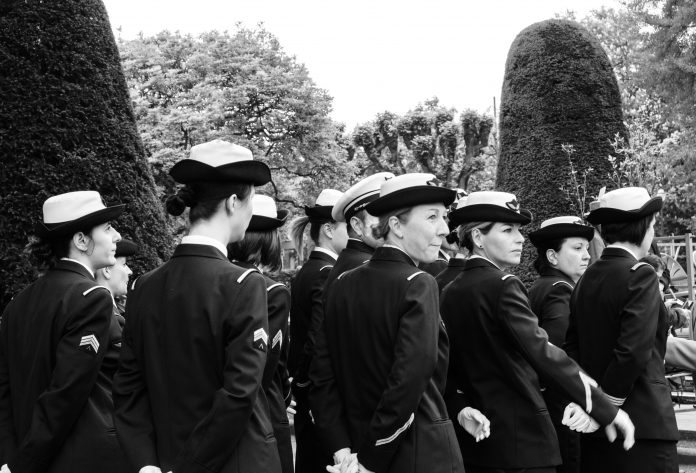Chris Girard, Associate Professor at Florida International University illustrates how the pre-existing cultural signals shaping gendered barriers are being transformed by coevolving informatics and women in the digital-era military
Digital-era informatics is revolutionising our understanding of gender inequality. Linking computation in natural and synthetic systems, informatics focuses on data flow. Coevolving informatics highlights information flows or signals, which—with greater system complexity—become increasingly independent from spatial and energy constraints. (1) Applying this tripartite schema (Fig. 1) it is evident that signals governing digital-age gender roles are gaining independence from sexual distinctions in body shapes (spatial) and muscles (energy conversion).
A prerequisite, but not a sufficient cause, of gender inequality is sexual dimorphism (dual shapes). Size, strength, and ferocity, on average, enable human males rather than females to wield greater site-controlling kinetic energy. This includes longer legs, larger lung capacity, and more oxygen-carrying haemoglobin, thereby enhancing exertion and speed. However, male dominance in claiming geophysical space is not universal. There are exceptions—such as spotted hyenas and ring-tailed lemurs—whereby females are favoured with greater size and site-controlling ferocity than males. In fact, females are larger than males and no less aggressive in around one-quarter of all mammalian species. This evidence suggests that territory-controlling dominance of males over females is not universally mandated by evolutionary selection pressures.

Siege Warfare
In agrarian societies, hand-to-hand combat in siege warfare appears to be a key factor elevating male dominance of territory and its resources. It is noteworthy that mobile foraging societies made territorial raids for plunder, revenge, and capturing women, but rarely for conquest. However, in settled agricultural societies, resource concentration in limited geographic locations (e.g., river valleys) was among the factors redirecting warfare increasingly towards territorial acquisition. Accordingly, among 590 cultures for which data were available, one scholar found that societies completing the transition from foraging to agriculture or herding were the most prone to war. (2)
Indeed, the Neolithic agrarian revolution spawned a “genuine burst of organised warfare,” along with fortifications. (3) Warfare became central to resource accumulation and wealth.
Agrarian siege warfare contributed to the evolution of gender inequality because sexual dimorphism endowed men with a comparative advantage in site-specific hand-to-hand combat. This advantage explains the historical pattern—until the very recent uptick in female military recruitment—wherein less than 1% of all warriors have been women. In agrarian societies, battles typically required close combat in which the soldier’s physical size and strength were often decisive. Men were thrust into direct contact with one another, armed with close-range melee weapons: swords, battle axes, maces, and spears. Longer-range weapons—slings, javelins, bows, and catapults—opened battles but rarely ended them. Insofar as melee combatants delivered their message through victim contact, the signal pathway and the weapon’s physical pathway were identical (Fig. 1, top). This contrasts with later mechanised wars in which signal decryption machines, such as Turing’s Enigma decoder, determined outcomes.
Siege warfare requiring hand-to-hand combat was not transformed substantially until the emergence of gunpowder as an extra-somatic (outside-the-body) energy source for military operations. Yet even as World War I began as a mobile war, it reverted to trench warfare demanding movement on foot. Industrial warfare using high-speed armoured tanks was not fully exploited until World War II. Insofar as industrial-age rifles could effectively strike an enemy at 500 yards or more, hand-to-hand combat became less frequent.
Mechanised-Cyber Warfare
Historically, female soldiers emerge when hand-to-hand combat is displaced by energy outside the body (gunpowder, fossil fuels) and when independent signals (radio, telephone) permit launching attacks far from targets.
Accordingly, a typical WWII combat role for women was an anti-aircraft gunner, which lacks the musculoskeletal demands of hand-to-hand fighting. The most notable exception to such preconditions for female warriors is Dahomey Kingdom (now Benin) from 1729 to 1894. Women comprised up to one third of all soldiers and at times several thousand were in combat positions wielding muskets and swords. More representative of warfare in which women participate would be WWII, when the Soviet Union mobilised up to 800,000 female soldiers. Women comprised 8% of the Soviet military but less than 1% of actual combat units. Epitomising enlarged distances between combatants and targets, the all-female 588th Air Regiment dropped bombs on German-occupied territories at night. Women were also deployed in integrated infantry units, receiving instruction in the use of mortars, machine-guns, and rifles.
Cultural signals shaping gendered barriers are being transformed by women in the digital-era military. Women are needed for information-intensive operations from drone flight to cyberwarfare (Fig. 1, bottom).
Moreover, a few exceptional women are qualifying for physically demanding infantry and serving on spatially confined submarines with men. Globally, progress is evident. Among military services in the U.S., the Air Force and Navy have the largest proportion of women (20%).
In 2005, China first opened the post of fighter jet pilot to women and India began training its first three female fighter pilots in 2018. Women became eligible for all combat positions in Germany in 2001, in the U.S. in 2016, and in the UK in 2018. These opportunities, based on talent, rather than gender are rooted in digital-age coevolving informatics—high-speed data, energy sources outside the body, and combat that is less constrained by distance and size.
References
Girard, C. Globalization and the erosion of geo-ethnic checkpoints: Evolving signal-boundary systems at the edge of chaos. Evolutionary & Institutional Economics Review 2020, 17, 93-109.
Wright, Q. A Study of War. 1942. appendix IX, table 11
https://archive.org/details/in.ernet.dli.2015.14629/page/n1
Ferrill, A. The Origins of War: From the Stone Age to Alexander the Great, Rev. ed.; Westview Press: Boulder, Colo., 1997.
Please note: This is a commercial profile
© 2019. This work is licensed under CC-BY-NC-ND.











